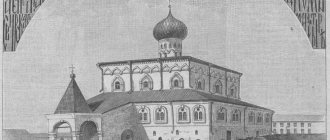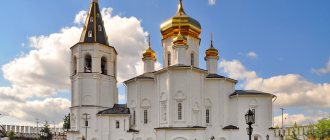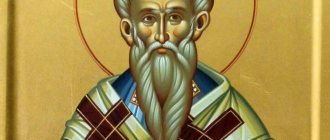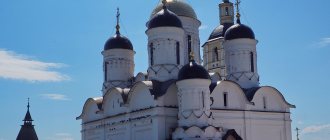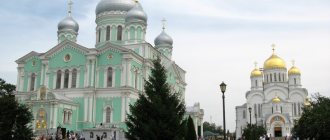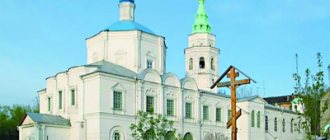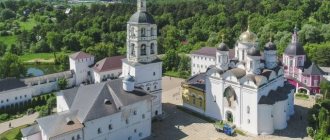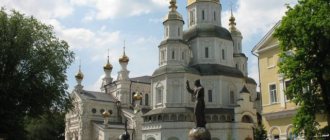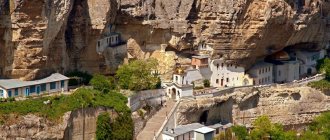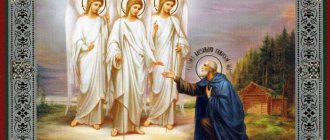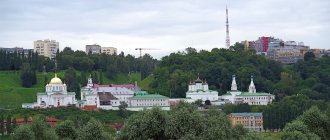How to get to the monastery
The monastery is located in a sparsely populated, secluded place on the territory of the Leningrad region. Nearest major cities with airports:
- Petrozavodsk - 180 km (2 hours 15 minutes by car);
- St. Petersburg - 250 km (2 hours 50 minutes drive).
The P-21 highway runs not far from the monastery. To get to the monastery you need to turn off from it at the village of Inema. Pilgrims can also get there by public transport with transfers in the town of Ladeinoye Pole. But you need to check the schedule and calculate everything, since buses do not go there often.
Useful links for planning your trip
Flights
Train schedule
Bus schedule
Excursions
Accommodation
Monastery founded by the Monk Alexander Svirsky
Alexander Svirsky was canonized 14 years after his death. This is an unprecedented event for Orthodoxy. Usually, for canonization, they wait for miracles to appear at the grave, etc. But the fame of this holy father was so great that this was not required.
Therefore, the Holy Trinity Monastery of Alexander Svirsky at all times was considered a very special place. It was founded by the monk himself, who settled in these then absolutely wild places in search of solitude.
According to the life of the saint, the site for the future monastery was indicated to Alexander by the Mother of God herself. And the abbot of the Valaam monastery, where he served, blessed him on his way. The monk found a place for his cell on the shore of the Holy Lake, 6 versts from the Svir River. From the name of this river he received the nickname Svirsky.
On Valaam there is the monastery of Alexander Svirsky.
For his spiritual exploits, he was endowed with the gift of foresight and the ability to heal the most severe mental and physical ailments. Therefore, soon a huge number of pilgrims flocked to the monastery.
After meeting the monk, many people stayed to live here. Of course, they settled at a distance from the place where the monk himself lived and prayed. Therefore, the monastery is divided into 2 parts - a complex of buildings:
- Trinity , where the fraternal cells were located;
- Preobrazhensky , where the saint prayed.
This monastery is quite ancient and has existed for more than 5 centuries. Its 500th anniversary was celebrated in 2006.
On the way to monasticism
The Monk Alexander Svirsky was born on June 28, 1448, in the village of Mandera, Olonets province. The saint's parents, Stefan and Vassa, were deeply religious people. For a long time they did not have children, and only when they reached adulthood did God, in response to their heartfelt prayers, give them a long-awaited child. The son was named Amos, in honor of the Old Testament biblical prophet.
Studies
His parents had the most tender feelings for Amos, but they did not forget about their responsibility before God for his upbringing. When the child grew up, he was assigned to learn to read and write with an experienced tutor. At first, studying was not easy for him. And Amos prayed a lot for help. God heard him and enlightened his mind. Over time, thanks to gracious support and, of course, personal diligence, Amos began to significantly surpass his peers in knowledge and piety.
Ascetic since childhood
He fenced himself off from the bustle of the world through ascetic work and prayer. From his youth he exhausted his flesh with abstinence, fasting, and vigil. Vassa, with love and maternal emotion, asked her son not to subject himself to such difficult exercises. He reassured her, answering that abstinence was pleasant to him.
When Amos reached marriageable age, his parents wanted to arrange his personal life: they wanted their son to start a family. But Amos avoided in every possible way. His heart drew him to the monastic path.
Secret departure from the parental home on Valaam
One day, the Providence of God brought him together with the Valaam monks, who arrived in his village for the needs of the monastery. They told him about the Valaam monastery, and talked about monasticism in general. These warm stories inflamed his heart and he began to beg the monks to take him with them. But they answered that they had no right to take children with them without parental consent without the blessing of the abbot. Meanwhile, one elder advised Amos not to delay fulfilling his desire until the devil filled his heart with tares.
When Amos finally decided to go to Valaam, he prayed before the road and secretly left his parents’ house. While spending the night on the shore of a beautiful lake, half asleep, he suddenly heard a mysterious voice. The one who called to him blessed his path and announced that one day a monastery would be built here. According to legend, the Lord also sent him an angel in the form of a traveler, who led him to the monastery gates.
Appearance of the Holy Trinity
In the twenty-third year of the solitude of Alexander Svirsky’s life, one of the greatest spiritual events took place - a meeting in man’s earthly life with God himself.
According to legend, God appeared to the monk in the form of the holy trinity - three angels. This was a completely unique phenomenon and there was a special reason for it.
At the time when he lived here around 1508, the heresy of the Judaizers was actively developing in Novgorod. These people argued that there is no trinity, but there is one God.
The heresy of the Judaizers found many supporters; even some of the hierarchs supported it. But there were also those holy people who fought against this heresy, such as Nil Sorsky and Alexander Svirsky.
At such a difficult moment for faith, this miracle happened.
There is a chapel in the courtyard at the entrance to the monastery. According to legend, it was here that the appearance of the Holy Trinity took place. The chapel itself was built later in memory of this event on this very site. It is called Trinity.
Once upon a time, the monk’s cell was located here instead. Here the angels came to him. The whole cell shone with an unprecedented light and he first fell to the ground in fear. But they raised him by the hand. That is, he held God's hand. Maybe that’s why the saint’s relics are incorruptible.
Orthodox film about the Svirsky monastery
Dear visitors! We offer for your viewing a film about the Holy Trinity Alexander-Svirsky Monastery. This powerful spiritual support of our Rus' is located in the Lodeynopolsky district of the Leningrad region.
In the historical past, this monastery was the spiritual center of the northern lands. Founded by the Monk Alexander of Svirsky in 1506, the monastery, over the 500-year period of its existence, suffered many disasters. But, despite the long thorny path, the monastery appears to us in sacred grandeur and beautiful splendor!
Orthodox film about the Svirsky monastery
In the northeast of the St. Petersburg diocese, near the border with Karelia, there is a monastery created 500 years ago with the blessing of the Holy Trinity by the great saint of God, Reverend Alexander Svirsky. We go there to see the legendary place, to venerate the relics of the saint, with which many secrets and extraordinary events are associated.
Monastery of St. Alexander Svirsky
These northern lands are rich in forests. Amazing landscapes, an abundance of springs, rivers, streams and reservoirs create a special atmosphere. Pine forests stand on sandy slopes framing clear lakes. Seagulls circle over the water. Local residents say that in 10 minutes in a forest clearing you can chop a bucket of mushrooms. And when the blueberries ripen, the soles of those leaving the forest are blue - the berries are poured out so abundantly.
Next to the monastery there is a cozy, high-quality hotel built by the monastery. It is equipped according to European standards. In addition to all the amenities, the cottages also have a kitchenette. There is also a cafe here. It is decorated in folklore style with a Russian stove at the head, decorated with ancient utensils and household items. The food here is good. In general, everything related to the monastery was done well and conscientiously. Here are photographs of the monastery's donors and its beautifiers. Their names are forever included in the monastery memorial. The list of investors in the monastery includes more than 50 famous boyar and noble families, including the Dolgorukovs, Naryshkins, Odoevskys, Pushkins, Repnins, Trubetskoys.
We drive up to the white stone monastery fence and leave the car in the parking lot. This mandatory rule did not allow even rulers to enter the monastery on horseback in the old days. The horses were tied at a hitching post outside the fence.
Here is the Holy Trinity Monastery. It stands on the high shore of Lake Roshchinskoye. Five centuries ago it was founded by the Monk Alexander of Svirsky in virgin forests among the pagan indigenous population. The monastery quickly gained good fame thanks to the strict ascetic lifestyle of the monastery’s founder. People began to flock here.
It must be said that the Valaam tonsure Alexander returned to his native land not so much in order to found a monastery, but in search of a secluded place for prayer.
In 1507, in the 23rd year of his settlement in the desert, an inexpressible light shone into the cell of the great ascetic during night prayer, and he saw Three Men dressed in white robes, each of them had a staff in his hand. Trembling, the monk bowed to them to the ground and exclaimed: “I have never seen anyone in such glory as I see you.” To which they answered him: “The Holy Spirit lives in you, for the sake of purity of your heart.”
The Monk Alexander received orders to build a church and found a monastery. And when he asked in whose name the monastery should be, the Lord answered: “Beloved, as you see him speaking to you in Three Persons, so build a church in the name of the Father and the Son and the Holy Spirit, the Consubstantial Trinity.”
A chapel was erected at the site of the appearance of the Holy Trinity. Until now, here the human soul is timid from the awareness of the stunning closeness of God to us.
The monk was shown by an Angel where to build the church in the name of the Holy Trinity. The angel marked the place for the temple three times in the shape of a cross and confirmed what had been revealed to the saint in knowledge. In great joy, Alexander Svirsky put a cross on this place. In the same year, the wooden church was cut down.
Gradually, a monastic community formed around the ascetic. At the fervent requests of the brethren, the monk received priestly rank and became abbot.
Hegumen Alexander ordered the construction of fraternal cells on the shore of Lake Roshchinskoye, at some distance from his own. The place where Alexander Svirsky’s cell stood was intended for a brotherly cemetery, and began to be called the Waste Hermitage. The wooden Church of the Transfiguration was built here. This was the beginning of two historically established parts of the Alexander-Svirsky Monastery: Trinity, on the site of the fraternal cells, and Preobrazhenskaya, on the site of the fraternal cemetery.
Most of the buildings are well preserved, demonstrating the high level of skill of Russian architects. But the buildings today require extensive restoration work. In 1997, the monastery was returned by the state to the Russian Orthodox Church. At the time of our shooting, not all buildings belonged to the monastery. In this wing, for example, there was a psychiatric hospital. When the film was already being edited, we learned that a decision had been made to transfer this hospital to the nearest city.
The Transfiguration Cathedral is the heart of the Holy Trinity Monastery, because it is here that the shrine with the relics of the saint is located. Eyewitness accounts indicate that when Alexander was buried in 1533, it was hard to believe that he had died, his face was glowing. Extraordinary events took place at his tomb. Those who came in faith received healing. There were so many miracles, and the holiness of the Svirsky abbot was so obvious that just 14 years after his death, the Monk Alexander of Svirsky was canonized. The case of such a quick canonization is rare. This usually takes centuries.
In 1641 the relics of St. Alexander were discovered. This event was also accompanied by unusual phenomena. Intending to build a new stone church over the body of the saint, the monks dismantled the old one, which burned down during the Polish-Swedish intervention. A thunderstorm began, but the lightning was strange. They fell to the ground, but did not disappear immediately, as is usually the case, but illuminated everything around for a long time.
Workers digging a ditch on the right side of the church foundation discovered the coffin. They were amazed that the ground above the coffin stood in the form of a cave, unsupported by anything. When the abbot and the brethren came and removed the top board of the coffin, a strong fragrance spread from the relics, and everyone saw the body completely intact and unharmed in the mantle and schema, from under which part of the beard was visible. The ascetic’s legs did not lie in their usual position, but the right one on the ankle joint of the left. With trepidation and joy, the monks saw how the fragrant myrrh spread over the body of the saint, like some growing flowers, and poured out like water. The myrrh was fragrant with roses and jasmine, and the saint’s body was soft and completely intact. The relics were transferred to the temple, and soon the Novgorod Metropolitan examined them. During the water-blessing prayer, the coffin was opened and the metropolitan revealed the face of the saint. The face was intact and absolutely similar to the icon that was placed at the coffin.
Video - category
Relics of Alexander Svirsky
The incorrupt relics of Alexander Svirsky are in the Trinity Cathedral of the monastery. The relics are displayed there only on major holidays, but now they are open here for a long time. Because within the Transfiguration Cathedral, where they are usually kept, restoration is underway.
Many people have no idea what exactly they look like. After all, most often in churches and temples we apply it to small particles of them, dressed in shrines or sealed inside the frame of icons. But what the incorruptible human body looks like is a mystery to many.
There is not a trace of decay on the relics of Alexander Svirsky, but life left this body almost 500 years ago. It is not possible to realize such a miracle immediately. Moreover, the relics are not kept in any special conditions, as is often the case: subject to a certain temperature and humidity.
They just lie in an open cancer.
Anyone can be convinced of this by simply venerating the relics. It seems to many that the saint’s flesh is warm, as if touching a living person.
Shock. This is what a person experiences when he finds himself next to these relics for the first time. All skepticism disappears when it comes to the realization that their authenticity has been confirmed by forensic experts. And even from the Soviet atheistic period.
Then the mind frantically begins to look for an explanation for what you see in front of you - there is no rational answer to this. There is no more precise answer, except that it is something inexplicable. A real miracle.
Alexander Svirsky's parents were devout peasants, but his dedication to faith worried them
Alexander Svirsky's parents named him in honor of the prophet Amos, the third of the twelve minor prophets, who preached in the Kingdom of Judea long before the birth of Christ.
The father's name was Stefan, the mother's name was Vassa. They lived in the village of Mandera (in other sources - the village of Mandera), which no longer exists. Now this place is decorated with the Vvedeno-Oyatsky Monastery.
The life of Stefan and Vassa took place in the usual peasant routine. They gave birth often then. It is known that before Amos, this family raised two children, who had already moved to separate homes.
For his parents, Alexander was a long-awaited child.
At least from his life we learn that his parents prayed for him with zeal. And then they heard a voice from above, assuring:
“Rejoice, good marriage, you will give birth to a son, in whose birth God will give consolation to His Churches.”
And although it is clear that Stephen and Bassa were devout people, young Amos's zeal for spiritual life came as a big surprise to them. The boy behaved meekly, tried to impose severe restrictions on himself, did not argue, and fasted zealously - to the point of exhaustion. But things weren’t going well for him with his studies.
This behavior worried the mother, who wanted a calmer life for her son. Together with their father, they decided to marry the young man, but these plans were not destined to come true.
Shrines of the monastery
Of course, the monastery also houses many other shrines: ancient icons, frescoes on the walls of the temple, particles of the relics of other saints. There is also a copy of the Shroud of Turin, which is kept in the Transfiguration part of the monastery.
There are only 6 such copies in the world. And one of them is located right here, in the monastery of Alexander Svirsky. Believers can see another one in the Sretensky Monastery in Moscow.
Also on the territory of the monastery there are two holy springs: a water-blessed chapel (the well of St. Alexander) and a well in honor of St. James, the Brother of the Lord in the flesh.
Monastic feat
After passing the test, Amos, at the age of twenty-six, took monastic vows and received a new name - Alexander. Some time later, after Amos left home, his father received news about him and found him in the monastery. Seeing in his son an ascetic exhausted by his exploits, but matured and strengthened in spirit, he shed tears, but he found words of consolation and encouraged him.
Hermitage on Lake Roshchinskoe
After spending 13 years in the monastery, Alexander began to look for a secluded, hermit-like residence. The elder, believing that the time had not yet come, held him back for the time being. But soon, with the intervention of God, Alexander received the desired blessing and retired in humility to Lake Roshchinskoe. The year was 1486.
At a distance of seven miles from Svir, in an impenetrable forest, he founded and built himself a modest cell. Here, in the wilderness, in complete silence, he lived a harsh ascetic life. In addition to physical difficulties, fallen spirits caused him a lot of trouble, annoying them with temptations and insurances, wanting to quickly drive the holy saint away.
Meeting with boyar Zavalishin
One day, while hunting, the boyar Zavalishin came to the saint’s dwelling, not at all expecting to meet a hermit monk in this remote corner of the forest. Frightened, he thought that there was a ghost in front of him, and then, having calmed down, he entered into a conversation with the monk and begged him to tell him about his life.
Alexander Svirsky, having made the boyar promise not to tell anyone about him, fulfilled the request. At the same time, the saint said that during the seven years of his stay here, he did not see people and never even ate bread, but only grass, and sometimes even earth. He also told how, when such food made his stomach sick and he felt unbearable, someone bright appeared to him and healed him of his illness, adding: “Don’t sin, work for the Lord!”
From then on, the amazed boyar began to provide the ascetic with what he needed for his existence.
Where to stay for a pilgrim
Despite the remoteness of the monastery, pilgrims can easily find shelter. There are several hotels and houses for pilgrims in neighboring settlements from the monastery. Prices start from 500 rubles for a bed in the hostel of the Svir Pilgrimage Center and reach several thousand for an individual cottage.
The “Pilgrimage Center” is located a 5-minute walk from the Monastery complex, 50 meters before the square, on the left side.
Svir Pilgrimage Center
Hotel "Staraya Sloboda" is located on the shore of Lake Roshchinskoye. It features a sauna, barbecue house, free Wi-Fi and free parking. The hotel has a small zoo and a riding club with its own stables. The Alexander-Svirsky Monastery is a few minutes' walk away.
Hotel Staraya Sloboda
Offering free private parking, Svirskaya Sloboda is located in Novaya Sloboda in the Leningrad Region.
Recreation center Svirskaya Sloboda
